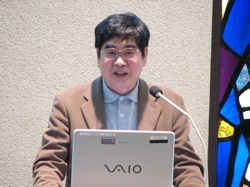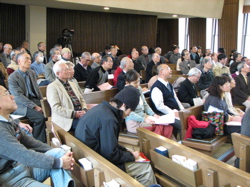Center for Interdisciplinary Study of Monotheistic Religions(CISMOR)Doshisha University
> Public Lectures > The Polytheistic World of SumerPublic Lectures
Lecture (Open for the public)
The Polytheistic World of Sumer
| Date: |
2008/01/12 14:00-16:00 |
|---|---|
| Place: | Chapel in the Divinity Hall, Imadegawa Campus, Doshisha Univ. |
| Lecture: | Prof. Toru Maeda (School of Letters, Waseda University) |
| Summary: | |
|
Professor Maeda explained the Sumerian view of the gods in the third millennium BC (the Early Dynasty, Akkadian Dynasty, and Ur Third Dynasty periods) based on investigations of cosmology, temples, statues of gods, and genealogical tables of gods. The third millennium BC Sumerian had an oppositional and systematic cosmology. In Sumerian cosmology, the world was divided broadly into the complete 'heaven' and the incomplete 'ground'; the 'underground' existed as the realm opposed to the 'ground,' where life subsists. In addition, the 'underground' was divided into the 'depths' (the world of the source of life) and the 'netherworld,' which was the world of the dead. On the other hand, the 'ground' was also divided between 'civilization' and the 'savage' realm outside civilization. Civilization was understood as analogous to the 'depths' represented by images of agriculture and water, while the domain of the savage was understood analogically as the 'netherworld' and expressed in images of wasteland and drying. In addition, Sumerians understood nature through analogies from the mythical cosmologies. That is to say, the Sumerians’ view of nature was divided into rich nature, which received the grace of gods, and barren nature, which received no grace from the gods. The Sumerians assigned the notion of 'temple' to the word that meant 'place where gods live.' That is, temples were understood as 'houses' where gods’ families dwelled. They were understood as management bodies of family property, for the owners of cultivated land. Statues of gods were understood as not statues but as the deities themselves. At that time, in Sumer, the destruction of temples and statues of gods was taboo. Moreover, the destruction of cities (= 'civilization') was originally considered taboo because they were regarded as graced by gods. But since the era of the territorial state which began in the last years of the Early Dynasty period, the kings came to quell the rebellions of city-states; kings were regarded as beings that gods entrusted with maintaining order. Thus, historical records of the destruction of cities were handed down since that time. The seven principal deities (An, Enlil, Enki, Nanna, Utu, Inanna, and Ninhursag) had a high degree of independence, and each had no relationship to the other. In Sumer, therefore, genealogical tables of gods were not drawn up. If they were drawn up in a later period, their contents varied. Each deity had the status of patron of cities; thus, the gods’ high level of independence was understood as resulting from the fact that each city retained independence after the formation of the united dynasty. On a related note, accepted opinion is that Inanna (the goddess of Ur) was held to be a fertility goddess from the beginning. At the end of the lecture, Professor Maeda raised a question about this accepted opinion. In his view, Inanna originally had only the aspect of goddess of war. After the formation of the third Ur Dynasty, a marriage rite came to be performed in all the territorial districts beyond the cities. According to Professor Maeda, the fertility aspect was added to Inanna at that time. Shunsuke Sugita (COE Research Assistant, Graduate Student of School of Theology, Doshisha University) |
|
|
Handout |
|

